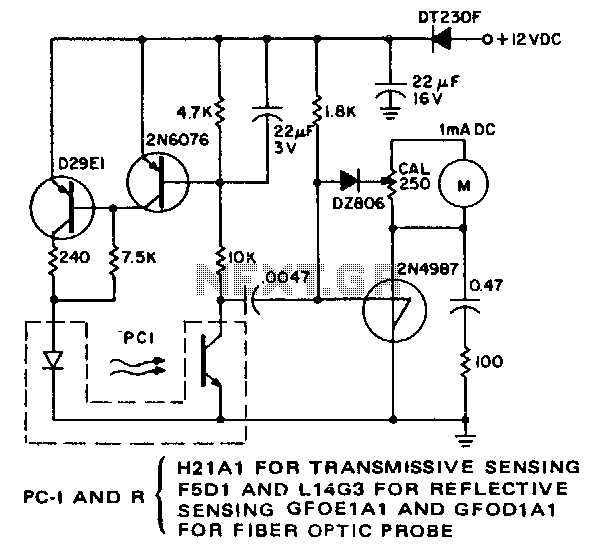
Optical-pick-up-tachometer

The purpose of this simple circuit is to enable remote, non-contact measurement of the speed of rotating objects. The circuit exhibits high linearity and accuracy, typically constrained by the milliammeter utilized and the initial calibration process. It is configured to count the leading edge of light pulses while disregarding normal ambient light levels. Designed for portable operation, the tachometer is not sensitive to supply voltage variations within the specified voltage tolerance. Full scale at maximum sensitivity of the calibration resistance is achieved at approximately 300 light pulses per second. A digital voltmeter can be employed on the 100 mV full-scale range instead of the milliammeter. To adapt the input of the digital voltmeter, it should be shunted with a 100-ohm resistor in parallel with a 100 microfarad capacitor. This RC network serves as a substitute for the filtering typically provided by the analog meter.
The circuit operates by detecting light pulses emitted by a rotating object, which can be achieved using a phototransistor or photodiode positioned to capture the reflected light. When the light beam is interrupted or reflected, the circuit registers a pulse corresponding to the rotation. The configuration allows for a high degree of sensitivity, ensuring that even low light levels from the object can be detected effectively while filtering out ambient light interference.
The calibration process involves adjusting the resistance to achieve the desired sensitivity, allowing the circuit to accurately reflect the speed of rotation in terms of light pulse count. The output can be displayed on a digital voltmeter, which provides a clear and precise reading of the speed. The use of a 100-ohm shunt resistor and a 100 microfarad capacitor creates a low-pass filter, smoothing out any rapid fluctuations in the signal and enhancing measurement stability.
This portable tachometer circuit is particularly useful in applications where traditional contact methods are impractical, such as in high-speed machinery or delicate components that cannot be physically touched. The design ensures reliable operation across a range of supply voltages, making it versatile for various environments and conditions.Remote, noncontact, measurement of the speed of rotating objects is the purpose of this simple circuit. Linearity and accuracy are extremely high and normally limited by the milliammeter used and the initial calibration.
This circuit is configured to count the leading edge of light pulses and to ignore normal ambient light levels. It is designed for portable operation since the tachometer is not sensitive to supply voltage within the supply voltage tolerance.
Full scale at the maximum sensitivity of the calibration resistance is read at about 300 light pulses per second. A digital voltmeter.can be used, on the 100-mV full-scale range, in place of the milliammeter. Shunt its input with a 100-0 resistor in parallel with a 100-~F capacitor. This rc network replaces the filtering supplied by the analog meter. 🔗 External reference
The circuit operates by detecting light pulses emitted by a rotating object, which can be achieved using a phototransistor or photodiode positioned to capture the reflected light. When the light beam is interrupted or reflected, the circuit registers a pulse corresponding to the rotation. The configuration allows for a high degree of sensitivity, ensuring that even low light levels from the object can be detected effectively while filtering out ambient light interference.
The calibration process involves adjusting the resistance to achieve the desired sensitivity, allowing the circuit to accurately reflect the speed of rotation in terms of light pulse count. The output can be displayed on a digital voltmeter, which provides a clear and precise reading of the speed. The use of a 100-ohm shunt resistor and a 100 microfarad capacitor creates a low-pass filter, smoothing out any rapid fluctuations in the signal and enhancing measurement stability.
This portable tachometer circuit is particularly useful in applications where traditional contact methods are impractical, such as in high-speed machinery or delicate components that cannot be physically touched. The design ensures reliable operation across a range of supply voltages, making it versatile for various environments and conditions.Remote, noncontact, measurement of the speed of rotating objects is the purpose of this simple circuit. Linearity and accuracy are extremely high and normally limited by the milliammeter used and the initial calibration.
This circuit is configured to count the leading edge of light pulses and to ignore normal ambient light levels. It is designed for portable operation since the tachometer is not sensitive to supply voltage within the supply voltage tolerance.
Full scale at the maximum sensitivity of the calibration resistance is read at about 300 light pulses per second. A digital voltmeter.can be used, on the 100-mV full-scale range, in place of the milliammeter. Shunt its input with a 100-0 resistor in parallel with a 100-~F capacitor. This rc network replaces the filtering supplied by the analog meter. 🔗 External reference
Warning: include(partials/cookie-banner.php): Failed to open stream: Permission denied in /var/www/html/nextgr/view-circuit.php on line 713
Warning: include(): Failed opening 'partials/cookie-banner.php' for inclusion (include_path='.:/usr/share/php') in /var/www/html/nextgr/view-circuit.php on line 713